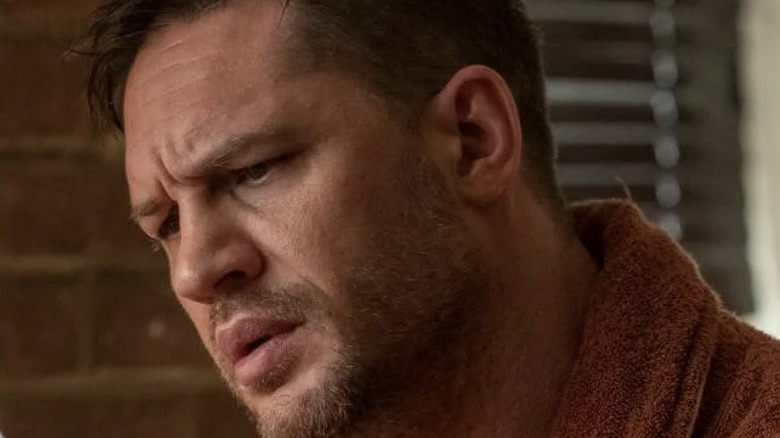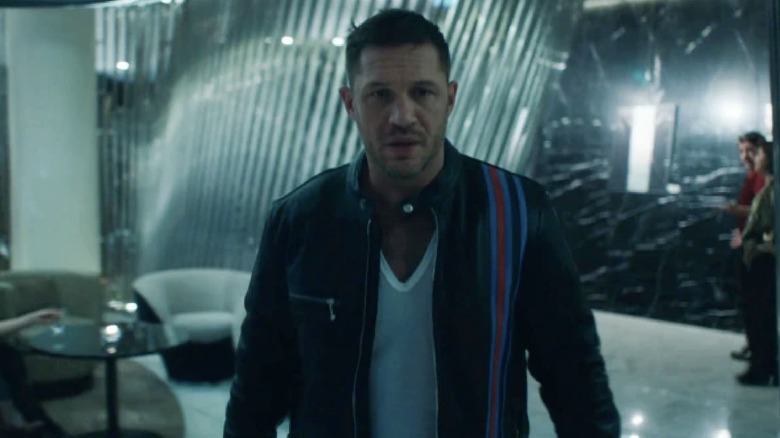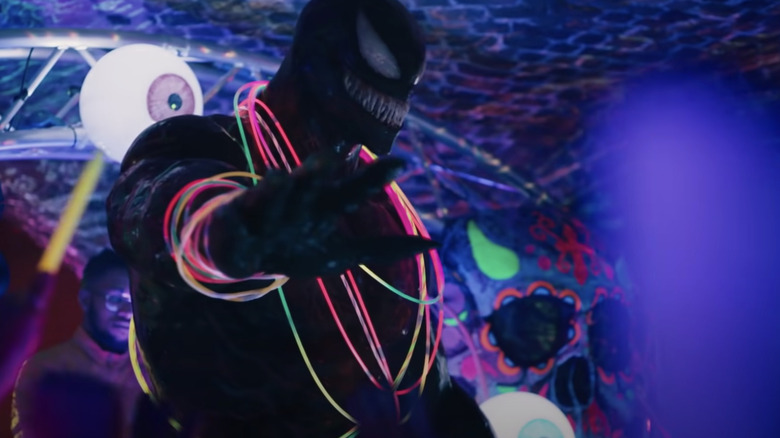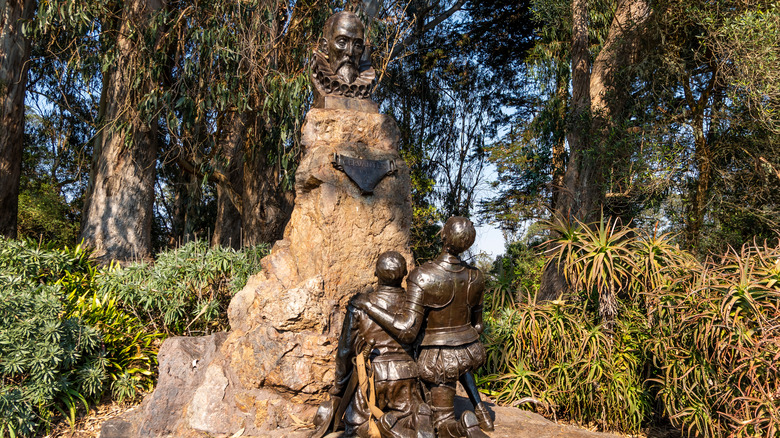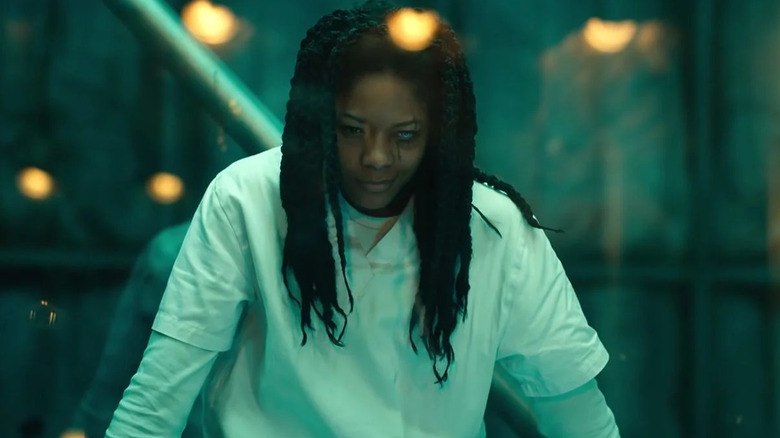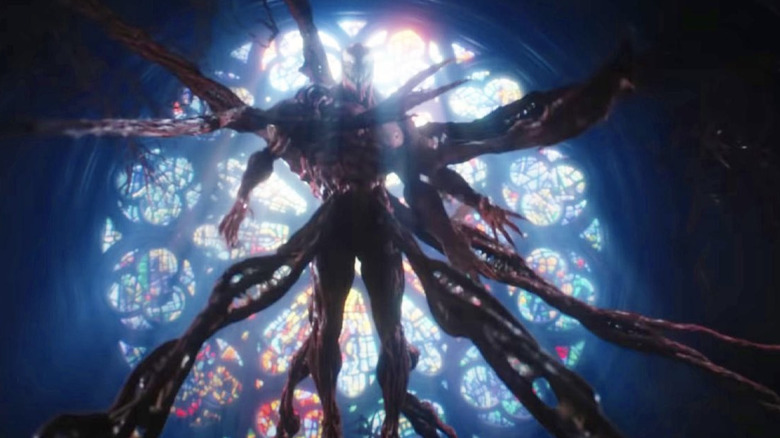The Biggest Unanswered Questions In Venom: Let There Be Carnage
With "Venom: Let There Be Carnage," Marvel movie fans finally get all kinds of answers. How is the new alliance between Eddie Brock and Venom working out? Will Anne ever dump Dr. Dan and get with a hero instead of a zero? Does the "Venom" franchise have any plans to intersect with your friendly neighborhood Spider-Man?
But it doesn't answer every question. In fact, by the time you leave the movie theater, you and your own personal symbiote (or spouse, or life partner, or date, or casual acquaintance) may find yourselves posing questions in the parking lot.
Well, "Venom 3" is way too far off to wait for answers, so we've rounded up a few of those burning questions that linger after the final frame of "Let There Be Carnage" has slithered, stabbed, and screeched across the screen. Keep in mind, there are massive spoilers ahead — but if you've seen the film, perhaps you might find some closure of your own.
Did Eddie kill his mother?
In a key scene, Eddie Brock goes to visit Cletus Kasady in San Quentin. At first trying to play things cool, Eddie finally loses it when the convicted serial killer begins comparing the two men. Kasady killed multiple members of his family; Brock, he claims, killed a family member when he was born.
In the comics, Eddie's mother did indeed die from complications during childbirth — a tragedy compounded when his father, Carl Brock, came to treat the child with an icy, angry detachment. Much of what Eddie became — athlete, star student, journalist — was in a desperate attempt to gain his father's approval and warmth.
In actuality, Brock is somewhat in the neighborhood of Cletus Kasady. While that first death may not have been his doing, an older Brock got drunk in the comics once and accidentally struck and killed a child with his father's car. In that storyline, Eddie wanted to turn himself in and face the music, but his dad talked him out of it.
Whichever Brock storylines are making their way to the silver screen, this much is certain: Eddie has some serious guilt on his shoulders. Kasady knows exactly which buttons to push, and when Eddie gets mad, Venom wants to help his buddy out. But ultimately, this fit of rage only leads to Kasady taking in the symbiote, causing more death and destruction.
Is Venom gay?
Those are three words you most likely didn't think you'd be asking yourself on the way out of the theater. But "Venom: Let There Be Carnage" has a scene where the symbiote, on the rebound after a bad breakup with Eddie, finds itself at a San Francisco rave. After turning down the advances of a woman (who thinks Venom is a person in a costume), the alien gets up on stage seeming like a few drinks may have passed over its enormous tongue and delivers a rant that includes the declaration: "I am out of the Eddie closet."
In an interview with Uproxx, director Andy Serkis referred to the rave as "an LGBTQIA kind of festival" and said the scene is a "coming out party" for the symbiote.
"Tom and Kelly were always about Venom coming out and going to a party that was a very sort of an LGBTQIA kind of festival, really, I'd call it," Serkis said of Tom Hardy and Kelly Marcel, the credited writers on the film. "So, this is his coming out party basically. This is Venom's coming-out party."
If this is true, Venom would seem to skyrocket to the top of high-profile LGBTQIA characters in comic book movies, having a higher profile than Iceman, Valkyrie, and possibly even Deadpool.
To perhaps put things more accurately, the two "Venom" films depict a mindset where gender fluidity makes such designations irrelevant. Venom can be a boy, a girl, or somewhere in between. It inhabits genders indiscriminately, and although it has come to appreciate Eddie Brock (even at one point declaring love for him), it also seems to enjoy inhabiting old Mrs. Chen's body and having Anne (Michelle Williams) get flirty.
"Yeah, you're the big sexy hero," Anne coos. "And I love seeing you in action."
The bottom line? By the end of the film, Venom seems happy and comfortable with itself. And ultimately, that's all that matters.
What's with the Cervantes references?
In a movie filled with people quoting poetry, Bible verses and even aliens belting out old Louis Armstrong/Ella Fitzgerald songs, one plot theme seems particularly out of left field: all the Cervantes talk.
Miguel de Cervantes (1547–1616) is widely regarded as one of the best Spanish language writers of all time, and in 1605 he penned "The Ingenious Gentleman Don Quixote of La Mancha." Throughout the film, Eddie Brock can be seen visiting what appears to be the Cervantes Memorial in Golden Gate Park — taking time to rest, getting his head right, and occasionally releasing chickens that Venom won't be eating for dinner (be free, Sonny and Cher!).
Near the end of the film, Eddie seems determined to school his ever-present companion on the themes in "Don Quixote," apparently drawing a parallel between themselves and the plight of Quixote and his companion Sancho Panza.
So, are Eddie and Venom just tilting at windmills? Possibly, but no matter how many times you read Cervantes, you most likely won't find a page where Don Quixote climbs into a tank and starts chomping the heads off lobsters.
How did Shriek get her powers?
Although "Venom: Let There Be Carnage" opens with a flashback going back several decades, the film doesn't flash back far enough to give viewers any idea where Shriek (aka Frances Barrison) got powers that are headlined by the ability to emit an eardrum-piercing scream that can kill humans and temporarily disorient sound-sensitive symbiotes like Venom and Carnage.
Instead, the audience meets Frances in a cell at St. Estes Reform School adjacent to Cletus Kasady, who makes her a paper promise ring before she is whisked off to her new home at Ravencroft mental institution.
Much of this is because, in a series where everyone else seems to be gaining powers via symbiotes, Shriek's talents are derived from her status as what is still (for now) a dirty word for Sony: mutant. Back around the turn of the century, as Marvel sold rights to various properties to studios, only 20th Century Fox secured the word, which it used quite liberally to promote an array of "X-Men" movies. Now, things appear to be on the path to mutants finally joining the MCU — but since the "Venom" films are technically Sony productions, you can see where things get muddled.
In the original Marvel comics, Shriek had a horrific upbringing that involved physical abuse, body-shaming, drug use, and even being shot in the head by a police officer. All this led to the awakening of her latent mutant abilities, which include sound manipulation, levitation, and even some psychic powers and mind control. All this makes the movie fate of Detective Mulligan (Stephen Graham) a bit confusing, since the comics have him becoming Toxin, yet Shriek's attack on him appears to have her transferring some sort of power that makes his eyes similarly glow blue.
So, did Shriek have some sort of symbiote in her back pocket that she put onto Mulligan during their confrontation? Or did she somehow transfer her powers? Let's just hope that by the time we find out in the next "Venom" movie, the characters can use the "m word" again.
What is a 'red one'?
Check out this video clip and you can see Venom's reaction the first time it sees Carnage in the flesh. Instead of jumping into the climactic smackdown, the black symbiote recedes back into Eddie Brock's body as if he's Hulk and just saw Thanos.
"Whoa, where are you going?" Brock asks his companion.
"That is a red one!" a panicked Venom exclaims.
As comic fans know, many symbiote species have their own colors, with Venom being black, Scream colored yellow, Sleeper being green, and so on. The reason why Carnage is red is because it entered Cletus through his bloodstream. In the comics, Eddie was in a prison cell with Cletus when Venom's spawn accessed Kasady through a cut in his hand.
In the movie, a somewhat similar event occurs, even if it gets tweaked a bit. Although Brock and Kasady aren't in a cell together, the serial killer manages to bite into Eddie. "I have tasted blood, and believe me, friend," he declares, "that is not it."
Whatever "it" is, it is compounded when the state tries to put Cletus Kasady to death via lethal injection. Carnage uses the opportunity to finally seize Kasady, breaking free from the restraints and beginning his killing spree.
So, why is Venom so afraid of a "red one"? Well, for starters, anyone can see that Carnage is clearly bigger and seems to have more weapons at the ready. It's also generally accepted that each spawn of a symbiote is stronger than the one before it, so Venom knows right off the bat that it is at a disadvantage. Also, it never helps when the symbiote you're about to go up against has chosen a host who just so happens to be a ruthless serial killer.
Seriously, two chefs?
Look, if you're going to make an audience sit through endless end credits hoping to glimpse a few seconds of where Sony's Spider-Man universe is headed next, we're going to notice some things. With "Let There Be Carnage," eyebrow-raising credits include "Mr. Hardy's Personal Chef" and "Mr. Harrelson's Personal Chef."
Okay, they're both major stars, and keeping up a decent physique so they can star in action movies like "Venom: Let There Be Carnage" is important. But keep in mind, any Hollywood production of this size already has a sizable catering budget that includes delicious food trucks — as well as chefs inside said truck who would most certainly do their best to whip up anything the film's two headliners wanted to eat.
Even if a personal chef was required for the big names, why can't Tom and Woody share? Can't one chef whip up two servings of skinless chicken breasts? Does there really need to be all these people on set, cooking up personalized meals? Honestly, folks, this is why we're paying almost $20 a movie ticket.
